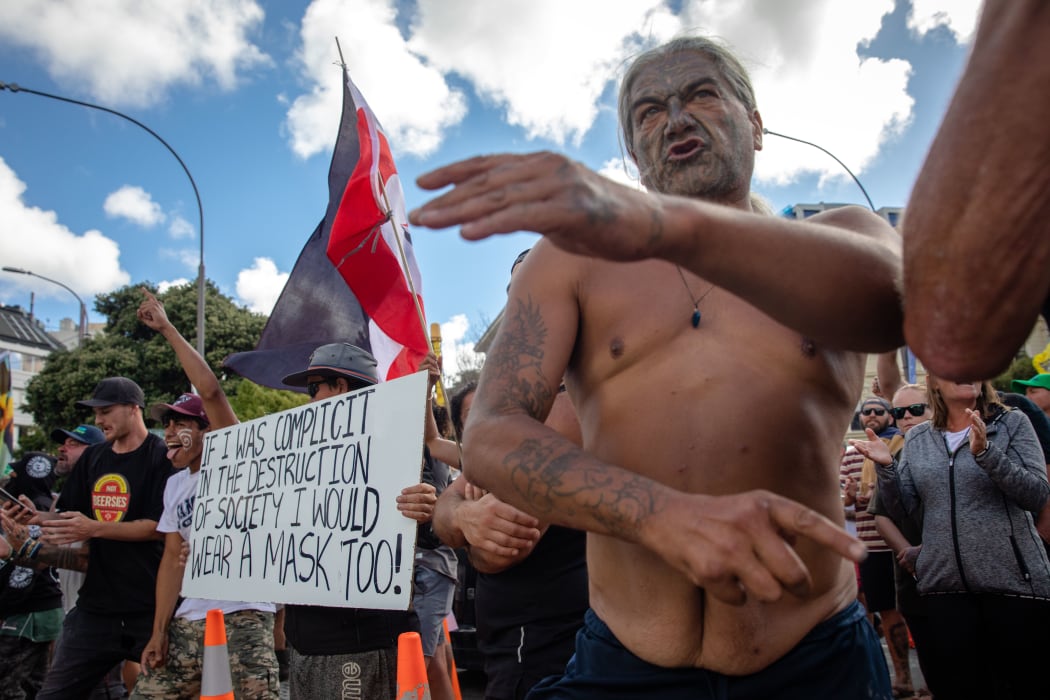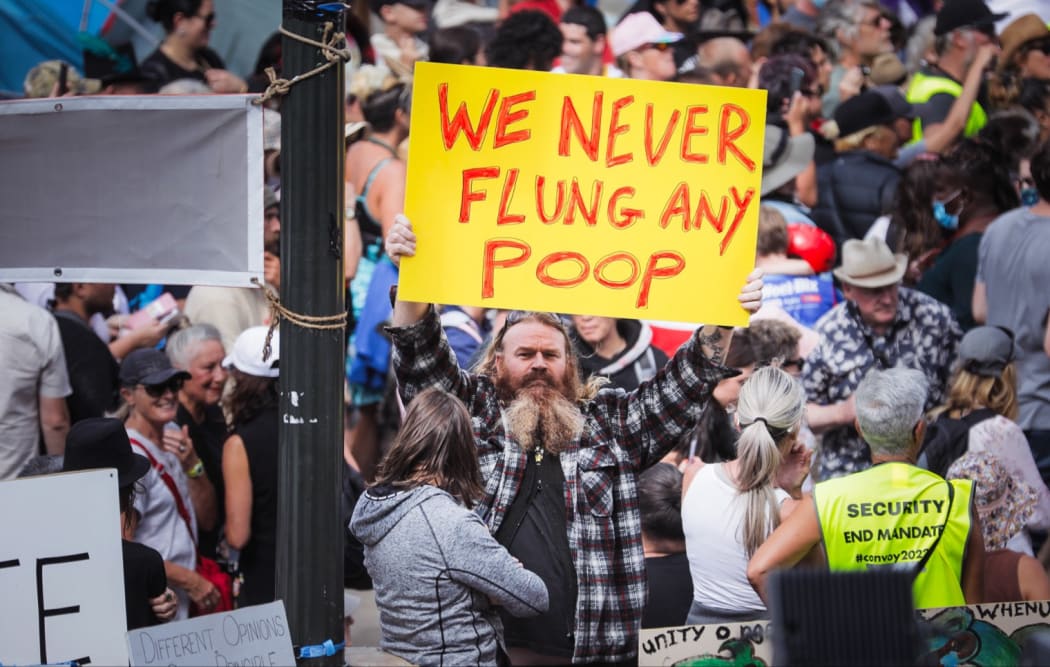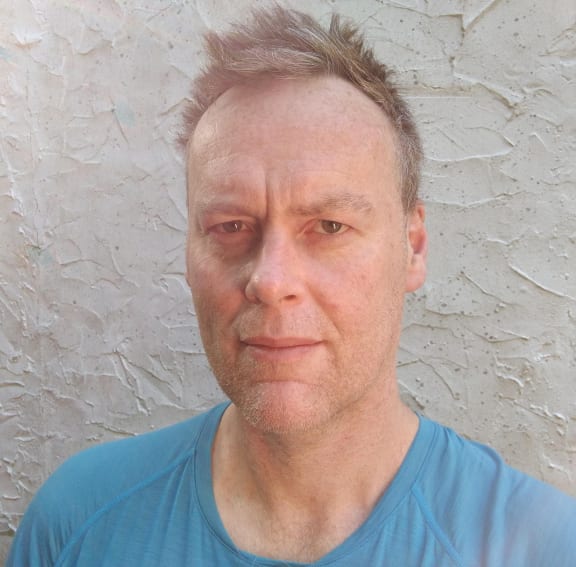The occupation around Parliament has become the most heavily-covered protest since the ‘81 Tour - in spite of the considerable hostility reporters have faced documenting it. But arguments still rage about what’s really happened and what it all means.

Protestors and Police standoff as police move concrete barricades Photo: RNZ / Angus Dreaver
This weekend protesters determined not to wear masks on their faces put tin foil hats on their heads to ward off imaginary radiation weapons which others were actively searching for.
The day before, a bloke outside Wellington Hospital waved a sign saying: “I know more than the scientists”.
So laughable it was hard to tell if they were for real - or joining in with a joke.
But no-one was laughing earlier in the week when a protester drove a car into a police line.
Or at protesters discussing using their children as a shield. Or at the prolonged and unhinged abuse of the PM and staff and parents at the primary school she was visiting near Christchurch on Friday.
All of this - and much more - undermined the opinions previously aired widely in the media that this was a movement focused on discriminatory vaccine mandates.
Voices insisting this was a mostly-peaceful protest reflecting legitimate concerns of Kiwis were also a lot harder to find in the media this week.
Another reason for that was a string of stories earlier about the worst kind of freedom camper behaviour at ‘Camp Freedom.’
But the details of these were sketchy, further feeding the anti-media paranoia among the protesters.
A police statement on Monday said they were “extremely appalled” by protesters’ behaviour, including human waste thrown at officers.
Other commentators confidently claimed the poo had been sourced from portaloos nearby, even though they couldn’t know that for sure - or who threw it.
Smartphones had captured many daytime flashpoints during the previous fortnight - but not this time.
Protesters claimed it never happened, and one waved a sign that got the media’s attention: “We never flung any poop.”

Photo: RNZ / Samuel Rillstone
Assistant Police Commissioner Richard Chambers also told reporters the police was the only agency able to investigate sexual assaults.
Pressed by reporters, he said that was prompted by “suggestions and chatter” within the occupation.
The same day three officers were taken to hospital after “being sprayed with a stinging substance”.
That was reported in the media to be acid - and this was repeated by outraged commentators throughout the day. But police still haven’t confirmed what the substance was.
Protesters seized on a single cellphone video they reckoned showed it was ‘friendly fire’ blowback from Police pepper spray.
“You have to start questioning all the other stories that the police have thrown out there without any verification whatsoever,” Heather du Plessis-Allan told NewstalkZb listeners on Tuesday.
“How much of what the police have told us is verifiable?” she asked.
The skepticism was music to the ears of protesters who, it turns out, do pay attention to mainstream media sometimes.
TVNZ’s Kristin Hall captured video of those comments playing on on a loudspeaker at the occupation the next day.
Protesters have been playing Newstalk ZB segments that question the accounts of police on loop via loudspeaker this morning pic.twitter.com/64VcdIxxSn
— Kristin Hall (@kristinhallNZ) February 23, 2022
On Tuesday the Wellington Regional Council also confirmed reports of protesters’ waste from vans being dumped into drains around Parliament. People were told not to swim at two waterfront sites and water sampling would be carried out.
Stuff reported that “swimmers and marine life alike would be splashing through human excrement.”
WRC chair Daran Ponter told RNZ’s Morning Report it was abhorrent and disrespectful to the environment.
Given the number of people and vans in and around Parliament and the small number of portaloos, it'd be a surprise if it hadn't happened.
But how do they know that it did?
Ponter told RNZ members of the public reported it.
But while Stuff reported on Tuesday that wastewater testing was being done in nine locations and culverts, no results have been reported since then.
All this came on top of anger about another sanitation outrage: images which allegedly showed a temporary toilet built onto the side of the Cenotaph.
The pictures went viral on social media even after it was confirmed that it was in fact a screened-off camp shower stall - and the occupiers took it down soon after the outcry began.
These unsavoury stories stiffened public resentment of the protest - but also fired protesters’ paranoid assertions the media were deliberately smearing their movement.
Canberra to Canada - the same dilemma
The Convoy’s conspiracists also reckoned it was no coincidence Canada’s government and cops were bringing the hammer down there, just as ours pushed back more here.
But in Canberra, protests and occupations have also been going on for weeks and Australia's media also struggled with whether to give the oxygen of publicity to fringe views.
“Do they deserve any sort of hearing? Well, on the opposition to vaccine mandates and the sacrifices they've made: yes, they do,” Paul Barry, host of the ABC’s Media Watch concluded last Monday.
“And good on those in the media who braved the hostile reception, and bothered to listen,” he added.
That was easier said than done in Wellington.
Late last week reporters were told by organisers they were free to report from the occupation site - and they even got an apology for previous obstruction and harassment.
But Stuff’s Henry Cooke was obstructed last Monday on the site and on Wednesday he was aggressively and abusively turned away well outside the protest site.
On Thursday, TVNZ’s deputy political editor Maiki Sherman even found herself trying to keep the peace between a parent and highly-agitated protesters who were at a primary school to abuse the visiting Prime Minister.
Protesters chase Ardern's vehicle down driveway after school visit and a parent ends up in a scuffle with a protestor who was filming her children. @1NewsNZ #nzpol https://t.co/5AnDet9af2
— Maiki Sherman (@MaikiSherman) February 24, 2022
Reporters copped it too, Sherman noted.
“The attention then turned to media with comments including, “f*** off, you’re dirty, you’re rotten”.
Some protesters claim they’re taking action to save our democracy - but clearly there isn’t much understanding of the role that the Fourth Estate plays in it, or any respect for those who do the job.

Tony Sutorius Photo: supplied
Tony Sutorius is a documentary-maker dedicated to depicting democracy in action - and the debate and dissent in all its forms that goes with it.
He was also ejected from the protest site when filming last week.
“I was there for a couple of hours when . . .they asked me if I supported the cause or not. I said I wasn't there for that reason. I was there to try to tell the truth as best I could about it,” he told Mediawatch.
“They decided to throw me out,” he said.
“One followed me down the road and wanted me to record my name and contact details into his phone so that they could put out a warning about me,” he said.
While it was a hostile environment for newsgathering, people could get footage ranging from short morsels online to hours of uninterrupted coverage of the site via apps and news websites.
“Nothing like that’s ever happened before,” Sutorius told Mediawatch.
“I think the media need to have a really hard think about that - and what it means. Everybody knows they can go and find moment-by-moment blow-by-blow live video of what's happening at this protest. The protesters themselves are putting it all over the internet,” he said.
“It's one thing to go and look at that on somebody's Telegram feed or some Facebook page, but to find it under the masthead of our biggest news organisations I think gives it a sense of prominence and significance that it probably wouldn't have otherwise” Sutorius said.
“If somebody goes to a media website or app, they are expecting information and claims that have actually been through an editorial process,” he said.
But alongside journalists’ reporting and analysis, doesn’t it help to have an unmediated picture of what's happening, especially when so many reports have been flatly denied and dismissed by protesters?
‘I wouldn't really call it unmediated because (that stage) is controlled by the protesters. That allows them to represent the issue exactly how they want.”
”I think one thing that the media also ought to think hard about is whether it's accurate to describe this is an anti-mandate protest. The accurate way to characterise the common beliefs of this crowd is that they don't believe in Covid,” he said.
“They believe that it's either not a thing at all - or it's not really dangerous. You really need to apply an editorial judgment and just be brave about it,” he said.
Sutorius has made public education films about elections and government, and also fly-on-the wall films such as Campaign, a vivid vignette of the first MMP election 25 years ago.
Will the current protest prove to be a big moment in our social history?
“That it isn't clear yet but the work that I've done so far suggests to me a significant part of the energy and anger underneath this is older than Covid. And I think that it will last longer than Covid does,” he said.
“If they really feel all politicians are the same and they should all be hung and the media can't be trusted, they're stepping outside and beyond democracy,” he said.
“It's probably good for our democracy and our future - and perhaps the way that our media functions - to be aware that there are people who are that mad and feeling that alienated from power sources in our society,” he said.
“When everyone's gone and the concrete blocks are gone and the lawns regrow, what's going to matter a lot more is what has gone back to our provincial towns and cities,” he said.
“I think it's great that the media have made a serious effort to engage and . . . been reasonably stoic about putting up with nonsense and a degree of risk to do that work. That's awesome, because that's what it's going to take,” Sutorius told Mediawatch.

